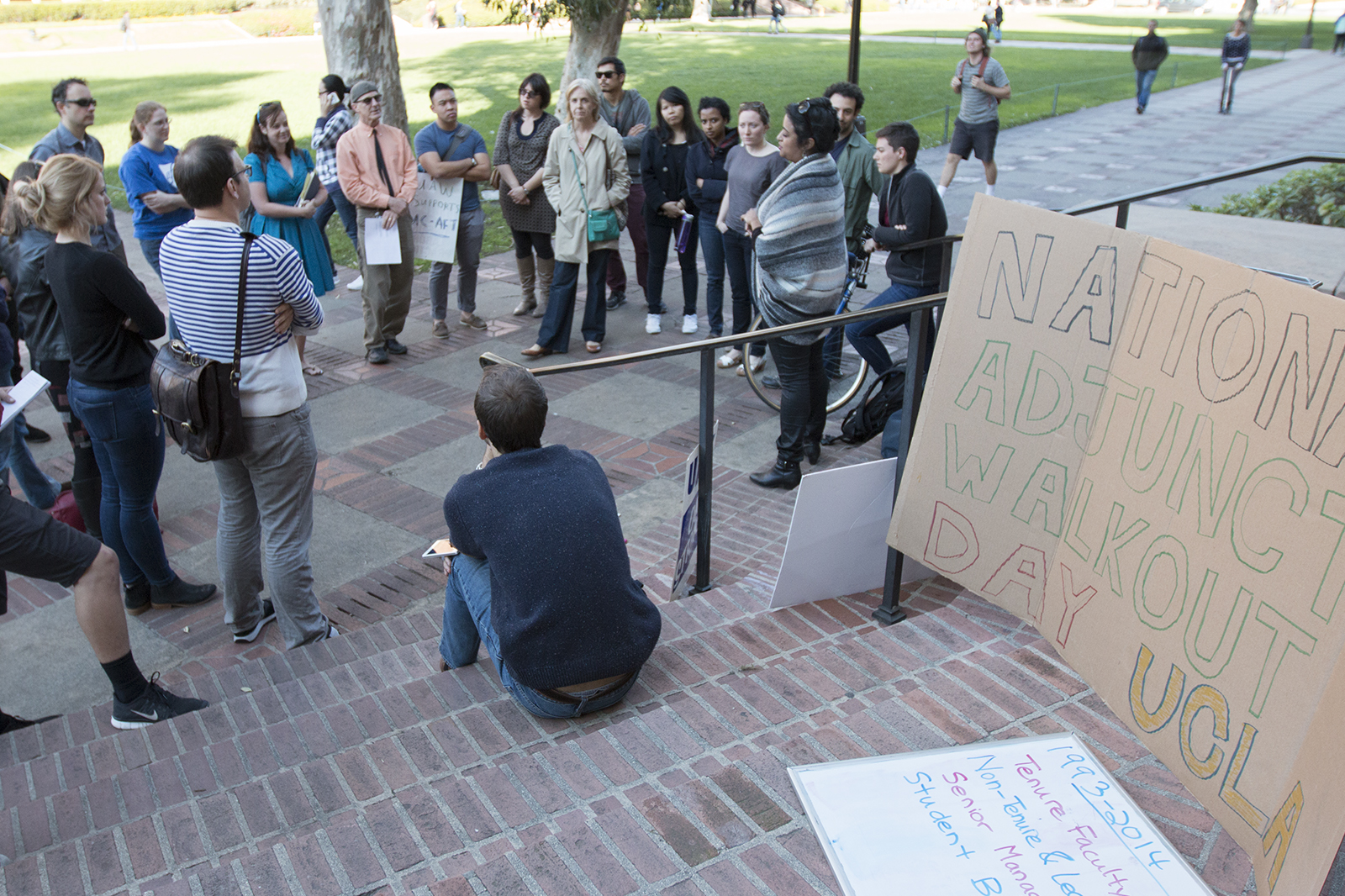Submission: Job stability is the only difference between lecturers, professors

Lecturers gathered for National Adjunct Walkout Day in February to inform the UCLA community of adjunct faculty members’ struggles with job insecurity from term to term. (Daily Bruin file photo)
By Karl Lisovsky
Sept. 24, 2015 8:47 a.m.
On your first day of class, you will probably assume that the instructor at the front of the room is a professor, right? You’ve got about a 50-50 chance of being right. Truth is, your instructor might be a lecturer or a professor. What’s the difference? No difference for you, the students. But, in fact, there is a difference.
Lecturers and professors can be any age, sex or ethnicity; they have doctorates, and all probably fulfill your expectation of what university instructors should be like: probably smart, maybe long-winded or maybe funny, maybe engaging, maybe hip. Certainly well versed in their field and committed to teaching you. You will find professors’ photos and biographies on their department websites; you may – or may not – find such information about a department’s lecturers on its website.
You see, a long time ago, before Proposition 13 and the many budget cuts that followed, university courses were taught by professors almost exclusively, people that had doctorates, did research and taught as experts in their fields. These people got tenure, a kind of security of employment that allowed them to pursue their research in an atmosphere of academic freedom. In addition to professors, the University occasionally hired lecturers, mostly as temporary instructors or as professionals from an applied field, people who worked, say, in the film and television industry or in business, and who came in to share real-world knowledge that pure academics would not have. However, these lecturers had other, “real” jobs; teaching was additional, done almost as a community service.
More recently, in these days of drastic budget cuts, things are much different: the University has been letting its professorship dwindle, and has been increasingly hiring lecturers to teach many of the same courses that professors have traditionally taught. Students don’t know the difference because, well, for you, there is no difference. You get the same classroom experience from a lecturer as from a professor. This switch from professors to lecturers has saved the University a lot of money and given it much flexibility. Lecturers are paid less than professors, and many of us don’t get health care or retirement. More importantly, we can’t get tenure, so departments can hire and let go of lecturers more or less at will.
The problem is this: While lecturers in the past might have had a “real” job in industry and were teaching at the University as a kind of bonus, for lecturers nowadays, teaching is the “real” job. And we are happy and proud to be doing it. Like professors, lecturers have doctorates, often do research and publish, and are fully involved in university and academic life. Except that for most of us, it can all end on a moment’s notice.
For example, say you just got your doctorate, got married and had a baby. And you are offered one class, maybe two, to teach in the fall. Will you be teaching in the winter? Maybe. You hope so. Perhaps you are lucky and get to teach part time all year long. However, that gig alone won’t allow you to make quite enough money to support your baby, so you must take another job, say, in Fullerton in the evenings. This, my friends, is the life of a “freeway flyer.”
And yet we persevere because we love and believe in what we do. And we believe in you, the students, your future, and the value of your education.
So, UCLA students, that person standing at the front of the room on the first day of class might be a professor with tenure, who spends his or her professional life on this one campus. Or that person might be a lecturer, sometimes known as “adjunct faculty,” who will give you every bit as good a class and office hour experience, but who probably juggles teaching assignments at multiple institutions, worries about having his or her job next quarter or next year and makes a fraction of the money. How can you tell if the person standing at the front of the class is a lecturer or a professor? You can’t.
Karl Lisovsky is a lecturer in Writing Programs, department of English. He is also on the executive board of the University Council-AFT, the professional labor union that represents lecturers and librarians.


